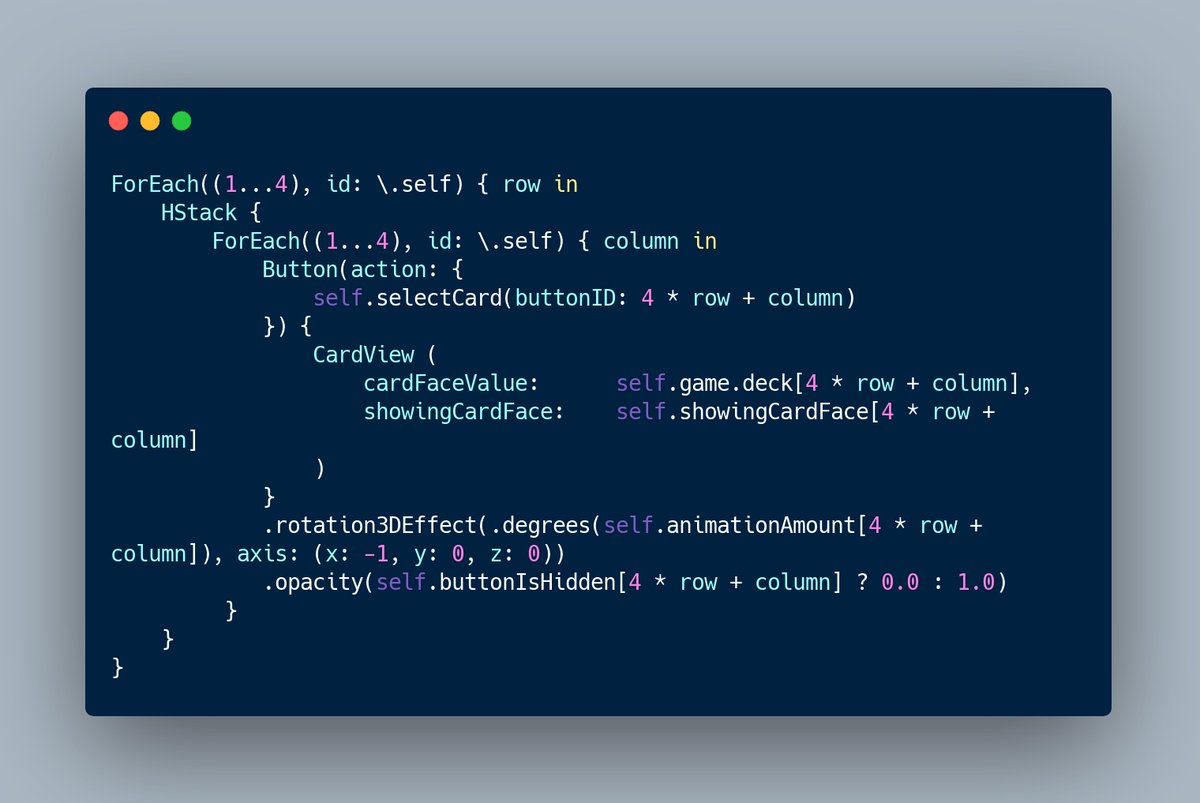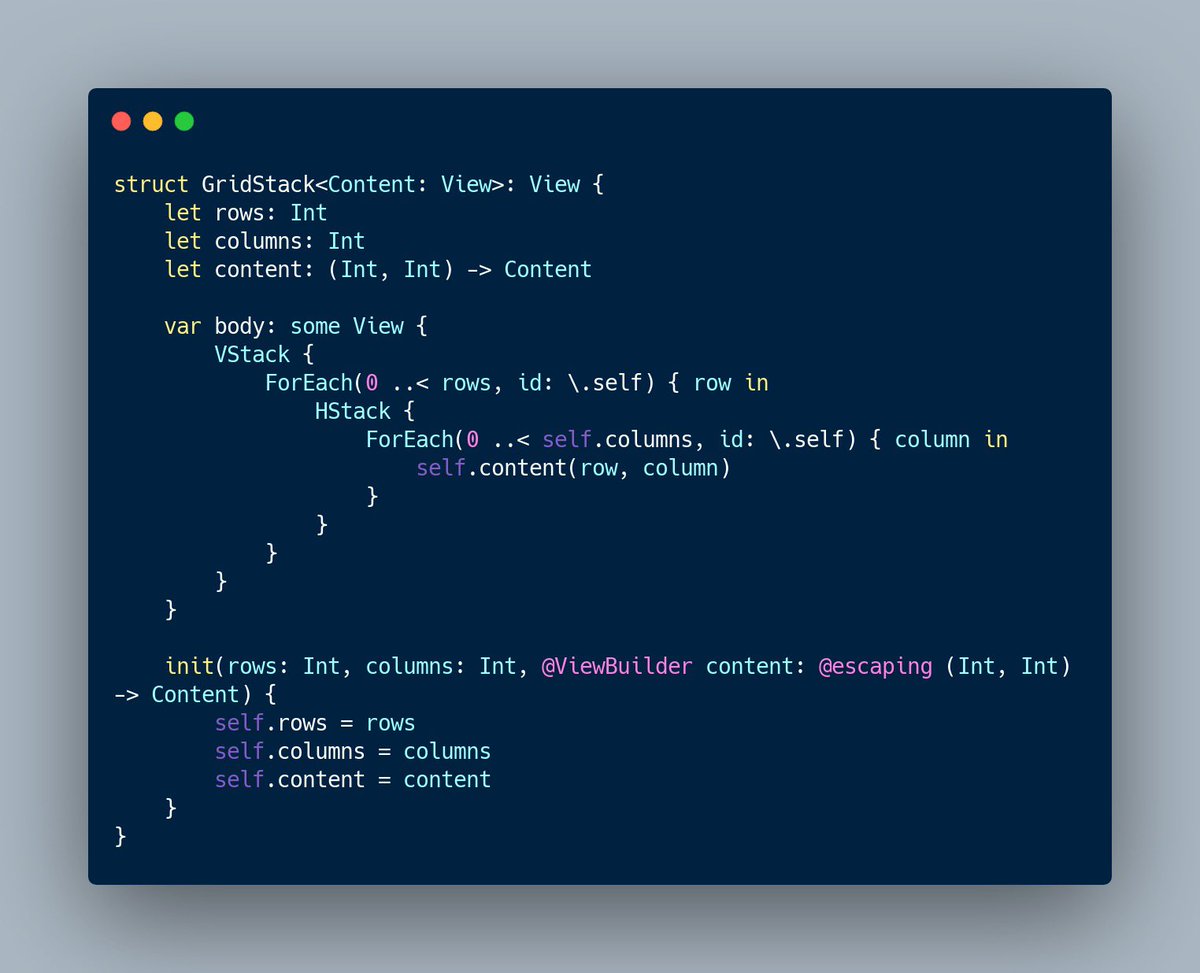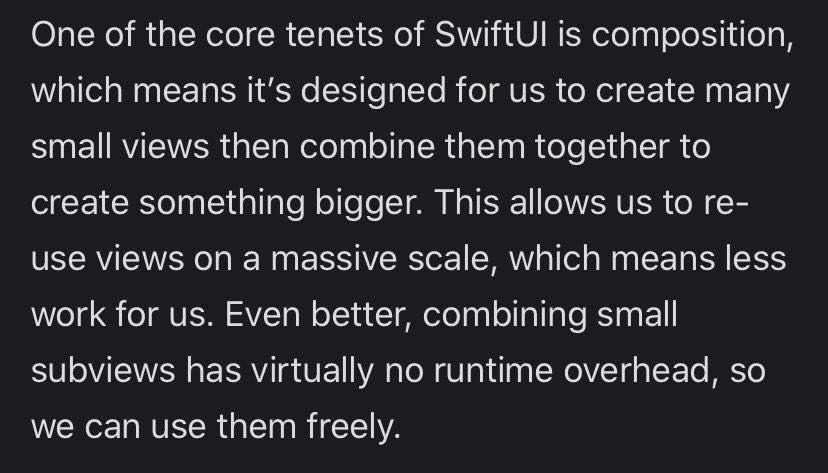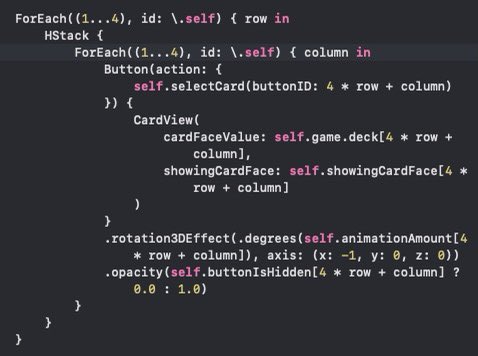A few days ago I cleaned up the code for my Memory game. I tried to apply two principles:
- make it readable
- make it DRY (don& #39;t repeat yourself)
I learned a lot from the experience, but there& #39;s one thing in particular I& #39;d like to share: how to display something in a grid
1/
- make it readable
- make it DRY (don& #39;t repeat yourself)
I learned a lot from the experience, but there& #39;s one thing in particular I& #39;d like to share: how to display something in a grid
1/
My Memory game displays 16 buttons: 4 rows, 4 columns. When I first wrote the app, I did exactly what you& #39;re not supposed to: I hardcoded *all* 16 buttons  https://abs.twimg.com/emoji/v2/... draggable="false" alt="🤣" title="Rolling on the floor laughing" aria-label="Emoji: Rolling on the floor laughing">
https://abs.twimg.com/emoji/v2/... draggable="false" alt="🤣" title="Rolling on the floor laughing" aria-label="Emoji: Rolling on the floor laughing">
2/
2/
Super repetitive. The exact opposite of DRY. And that matters because it makes mistakes and bugs so much more likely.
3/
3/
So how to fix it? Well, if you& #39;re doing #100DaysOfSwiftUI you might remember that ForEach allowed us to make all three flag buttons while writing the code for just one.
That& #39;s DRY, but problem: my buttons needed to be nested in 4 rows of HStacks.
4/
That& #39;s DRY, but problem: my buttons needed to be nested in 4 rows of HStacks.
4/
How do you inject that formatting? I thought about it long and hard. I finally realized I could solve this by nesting a ForEach inside a ForEach.
Damn I felt smart.
5/
Damn I felt smart.
5/
But then the code wouldn& #39;t compile.
"The compiler is unable to type check this expression in a reasonable time"
6/
"The compiler is unable to type check this expression in a reasonable time"
6/
Well it would compile if commented out lots of stuff including my animations.
But animations make the game fun and there should be a way to make it work right?
7/
But animations make the game fun and there should be a way to make it work right?
7/
Stack Overflow was full of threads with similar Xcode compiler issues. Lots of people complaining that the Xcode compiler isn& #39;t good enough.
Maybe. But I just want my app work.
8/
Maybe. But I just want my app work.
8/
After my 5th or 6th Google search a solution surfaced.
Yup, a tutorial from @twostraws https://abs.twimg.com/emoji/v2/... draggable="false" alt="😆" title="Smiling face with open mouth and tightly-closed eyes" aria-label="Emoji: Smiling face with open mouth and tightly-closed eyes">
https://abs.twimg.com/emoji/v2/... draggable="false" alt="😆" title="Smiling face with open mouth and tightly-closed eyes" aria-label="Emoji: Smiling face with open mouth and tightly-closed eyes">
https://www.hackingwithswift.com/quick-start/swiftui/how-to-position-views-in-a-grid
9/">https://www.hackingwithswift.com/quick-sta...
Yup, a tutorial from @twostraws
https://www.hackingwithswift.com/quick-start/swiftui/how-to-position-views-in-a-grid
9/">https://www.hackingwithswift.com/quick-sta...
Paul& #39;s solution is surprisingly similar to mine: it relies on a ForEach nested inside a ForEach. The key difference is that the grid is placed inside its own view.
So why does that work?
10/
So why does that work?
10/
Paul writes:
https://www.hackingwithswift.com/quick-start/swiftui/how-to-create-and-compose-custom-views
11/">https://www.hackingwithswift.com/quick-sta...
https://www.hackingwithswift.com/quick-start/swiftui/how-to-create-and-compose-custom-views
11/">https://www.hackingwithswift.com/quick-sta...
Less work for us. But also apparently less work for the compiler.
So what& #39;s going on? Luckily @twostraws has another explainer that I think answers this question.
It has to do with type inference.
https://www.hackingwithswift.com/example-code/language/how-to-fix-the-error-expression-was-too-complex-to-be-solved-in-reasonable-time
12/">https://www.hackingwithswift.com/example-c...
So what& #39;s going on? Luckily @twostraws has another explainer that I think answers this question.
It has to do with type inference.
https://www.hackingwithswift.com/example-code/language/how-to-fix-the-error-expression-was-too-complex-to-be-solved-in-reasonable-time
12/">https://www.hackingwithswift.com/example-c...
I think this makes sense because one of things I noticed when my project wouldn& #39;t compile is that sections of my code no longer had syntax highlighting.
13/
13/
So is that the answer?
Breaking up your code into smaller views means:
- less work for the programmer (DRY)
- less work for the CPU in terms of type inference
I& #39;m curious though. Are there other reasons to break up code into smaller views?
Thanks for reading.
14/ End
Breaking up your code into smaller views means:
- less work for the programmer (DRY)
- less work for the CPU in terms of type inference
I& #39;m curious though. Are there other reasons to break up code into smaller views?
Thanks for reading.
14/ End

 Read on Twitter
Read on Twitter






